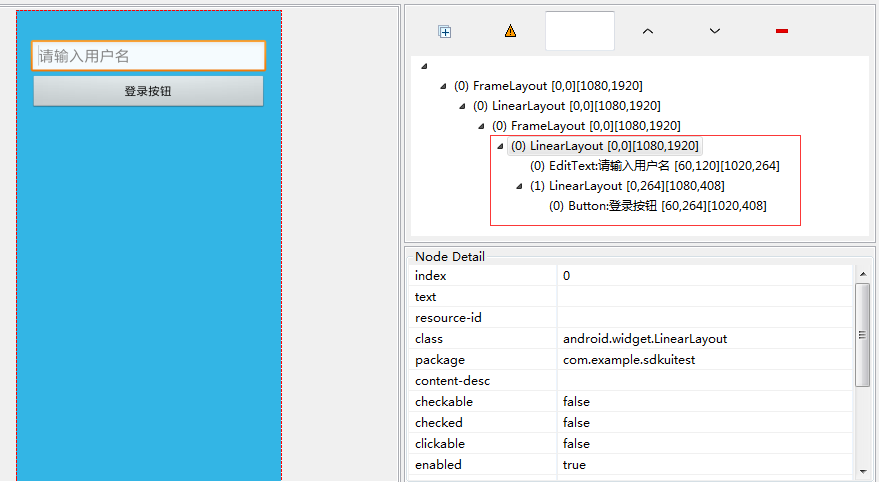Android布局优化:include 、merge、ViewStub的详细总结
一、include的用法以及注意点
在开发Android布局时,我们常将一些通用的视图提取到一个单独的layout文件中,然后使用标签在需要使用的其他layout布局文件中加载进来,比如我们自己App导航栏等。这样,便于对相同视图内容进行统一的控制管理,提高布局重用性。
下面我们以大部分项目中都有的头部导航栏为例,说明一下include的使用,比如我们项目自己统一头部导航栏,抽取布局如下:
titlebar.xml:
<?xml version="1.0" encoding="utf-8"?>
<RelativeLayout xmlns:android="http://schemas.android.com/apk/res/android"
android:layout_width="match_parent"
android:layout_height="match_parent" >
<Button
android:id="@+id/back"
android:layout_width="wrap_content"
android:layout_height="wrap_content"
android:layout_alignParentLeft="true"
android:layout_centerVertical="true"
android:text="返回按钮" />
<TextView
android:id="@+id/title"
android:layout_width="wrap_content"
android:layout_height="wrap_content"
android:layout_centerInParent="true"
android:text="提示文字"
android:textSize="20sp" />
<Button
android:id="@+id/close"
android:layout_width="wrap_content"
android:layout_height="wrap_content"
android:layout_alignParentRight="true"
android:layout_centerVertical="true"
android:text="关闭按钮" />
</RelativeLayout>
很简单,就是左右各一个按钮,中间是一个提示文字。使用也比较简单,如下:
activity_main.xml:
<RelativeLayout xmlns:android="http://schemas.android.com/apk/res/android"
xmlns:tools="http://schemas.android.com/tools"
android:layout_width="match_parent"
android:layout_height="match_parent"
tools:context="${relativePackage}.${activityClass}" >
<include
android:layout_width="match_parent"
android:layout_height="40dp"
layout="@layout/titlebar" />
<Button
android:layout_width="wrap_content"
android:layout_height="wrap_content"
android:layout_centerHorizontal="true"
android:layout_centerVertical="true"
android:onClick="click"
android:text="点我。。。" />
</RelativeLayout>
include标签使用还是很简单的,主要通过layout属性声明要引入的布局即可。运行程序界面如下:
include标签使用注意点:
1,标签当中,可以重写所有layout属性的,如上面include中指定的layout属性将会覆盖掉titlebar中指定的layout属性。 而非layout属性则无法在标签当中进行覆写。另外需要注意的是,如果我们想要在标签当中覆写layout属性, 必须要将layout_width和layout_height这两个属性也进行覆写,否则覆写效果将不会生效 2,一个xml布局文件有多个include标签需要设置ID,才能找到相应子View的控件,否则只能找到第一个include的layout布局,以及该布局的控件。 3,如果我们给include所加载的layout布局的根容器设置了id属性,也在include标签中设置了id属性,同时需要在代码中获取根容器的控件对象时,最好将这两个id设置相同的名称!否则,可能获取不到根容器对象,即为null。
二、merge的用法以及注意点
merge标签存在的意义是帮助include标签排除多余的一层ViewGroup容器,减少view hierarchy的结构,提升UI渲染的性能。include标签存在着一个不好的地方,可能会导致产生多余的布局嵌套。同样通过一个小demo来说明:
比如项目中有一个公共的登录按钮布局,如下:
login.xml:
<?xml version="1.0" encoding="utf-8"?>
<LinearLayout xmlns:android="http://schemas.android.com/apk/res/android"
android:layout_width="match_parent"
android:layout_height="wrap_content"
android:orientation="vertical" >
<Button
android:layout_width="match_parent"
android:layout_height="wrap_content"
android:layout_marginLeft="20dp"
android:layout_marginRight="20dp"
android:text="登录按钮" />
</LinearLayout>
很简单,就是一个登录的Button。
项目中有登录功能的UI界面如下:
activity_login.xml:
<LinearLayout xmlns:android="http://schemas.android.com/apk/res/android"
xmlns:tools="http://schemas.android.com/tools"
android:layout_width="match_parent"
android:layout_height="match_parent"
android:orientation="vertical"
android:background="@android:color/holo_blue_light">
<EditText
android:layout_width="match_parent"
android:layout_height="wrap_content"
android:layout_marginLeft="20dp"
android:layout_marginRight="20dp"
android:layout_marginTop="40dp"
android:hint="请输入用户名" />
<include layout="@layout/login" />
</LinearLayout>
同样非常简单,运行程序,如下:
看起来没什么问题,其实不知不觉中我们多嵌套了一层布局。我们用工具查看一下此时布局结构:
除去系统布局,我们自己布局最外层是LinearLayout,然后两个并列布局EditText与LinearLayout,在LinearLayout里面是Button登录按钮。
其实这种情况下:在主界面中,
这里我们把activity_login.xml修改如下:
<?xml version="1.0" encoding="utf-8"?>
<merge xmlns:android="http://schemas.android.com/apk/res/android">
<Button
android:layout_width="match_parent"
android:layout_height="wrap_content"
android:layout_marginLeft="20dp"
android:layout_marginRight="20dp"
android:text="登录按钮" />
</merge>
重新运行程序UI和上面一样效果,通过工具再次查看布局结构;
看到了吧,我们自己布局减少了一层嵌套,从而提升了UI的渲染速度。
merge标签使用注意点:
1,根布局是FrameLayout且不需要设置background或padding等属性,可以用merge代替,因为Activity的ContentView父元素就是FrameLayout,所以可以用merge消除只剩一个.
*2,因为merge标签并不是View,所以在通过LayoutInflate.inflate()方法渲染的时候,第二个参数必须指定一个父容器,且第三个参数必须为true,也就是必须为merge下的视图指定一个父亲节点.由于merge不是View所以***对merge标签设置的所有属性都是无效的.
LayoutInflate中源码体现:
public View inflate(XmlPullParser parser, @Nullable ViewGroup root, boolean attachToRoot) {
synchronized (mConstructorArgs) {
...
if (TAG_MERGE.equals(name)) {
if (root == null || !attachToRoot) {
throw new InflateException("3,merge标签必须使用在根布局,并且ViewStub标签中的layout布局不能使用merge标签.
三、ViewStub的用法以及注意点
ViewStub也可以用来加载布局文件,但与include标签完全不同。ViewStub是一个不可见的View类,用于在运行时按需懒加载资源,只有在代码中调用了viewStub.inflate()或者viewStub.setVisible(View.visible)方法时才内容才变得可见。这里需要注意的一点是,当ViewStub被inflate到parent时,ViewStub就被remove掉了,即当前view hierarchy中不再存在ViewStub,而是使用对应的layout视图代替。
同样我们通过一个小demo说明一下,比如我们需要保存一个用户信息,用户名是必须保存的,但是其余信息是不必要的,这是其余信息就可以一开始不显示出来,用户想输入的时候在现实出来。
其余信息布局如下:
otherinfo.xml:
<?xml version="1.0" encoding="utf-8"?>
<LinearLayout xmlns:android="http://schemas.android.com/apk/res/android"
android:layout_width="match_parent"
android:orientation="vertical"
android:layout_height="wrap_content" >
<EditText
android:id="@+id/weichat_id"
android:layout_width="match_parent"
android:layout_height="wrap_content"
android:layout_marginLeft="20dp"
android:layout_marginRight="20dp"
android:layout_marginTop="10dp"
android:hint="请输入微信号" />
<EditText
android:id="@+id/address_id"
android:layout_width="match_parent"
android:layout_height="wrap_content"
android:layout_marginLeft="20dp"
android:layout_marginRight="20dp"
android:layout_marginTop="10dp"
android:hint="请输入家庭住址" />
</LinearLayout>
很简单,没什么其余解释的,主界面布局如下:
activity_main.xml:
<LinearLayout xmlns:android="http://schemas.android.com/apk/res/android"
xmlns:tools="http://schemas.android.com/tools"
android:layout_width="match_parent"
android:layout_height="match_parent"
android:background="@android:color/holo_blue_light"
android:orientation="vertical" >
<EditText
android:layout_width="match_parent"
android:layout_height="wrap_content"
android:layout_marginLeft="20dp"
android:layout_marginRight="20dp"
android:layout_marginTop="40dp"
android:hint="请输入用户名" />
<ViewStub
android:id="@+id/viewstub"
android:layout_width="match_parent"
android:layout_height="wrap_content"
android:layout="@layout/otherinfo" />
<Button
android:layout_width="match_parent"
android:layout_height="wrap_content"
android:onClick="show"
android:layout_marginLeft="20dp"
android:layout_marginRight="20dp"
android:layout_marginTop="10dp"
android:text="显示" />
</LinearLayout>
其余信息界面通过ViewStub引入进来,关于ViewStub主要属性以及方法说明如下:
android:layout属性 加载包含的layout布局文件;
android:inflatedId属性 重写包含的layout布局文件的根容器id;
inflate()方法 与setVisible(int)方法作用类似,都可以使内容得以显示,只是inflate()会返回一个View对象,避免了额外使用findViewById()方法获取layout视图对象。
activity中代码如下:
public void show(View view){
//
ViewStub stub = ((ViewStub) findViewById(R.id.viewstub));
if(stub!=null){
View stubView = stub.inflate();
EditText address = (EditText) stubView.findViewById(R.id.address_id);
EditText wechatId = (EditText) stubView.findViewById(R.id.weichat_id);
}
}
好了,运行程序,一开始如下:
点击显示按钮,UI如下:
ViewStub标签使用注意点:
1,ViewStub标签不支持merge标签。因此这有可能导致加载出来的布局存在着多余的嵌套结构,具体如何去取舍就要根据各自的实际情况来决定了。 2,ViewStub的inflate只能被调用一次,第二次调用会抛出异常。 3,虽然ViewStub是不占用任何空间的,但是每个布局都必须要指定layout_width和layout_height属性,否则运行就会报错。
好了,以上就是个人对于include 、merge、ViewStub使用的总结,希望对你有用,即使已经掌握,希望读完此文能温故知新。
如果你看到了这里,觉得文章写得不错就给个赞呗?如果你觉得那里值得改进的,请给我留言。一定会认真查询,修正不足。谢谢。
最后针对Android程序员,我这边给大家整理了一些资料,
给大家分享一套由阿里高级架构师编写的《Android八大模块进阶资料》,帮助大家将杂乱、零散、碎片化的知识进行体系化的整理,让大家系统而高效地掌握Android开发的各个知识点。
由于文章内容比较多,篇幅有限,资料已经被整理成了PDF文档,有需要《Android八大模块进阶资料》完整文档的可以加微信 即可免费领取!
PS:(文末还有使用ChatGPT机器人小福利哦!!大家不要错过)
《Android八大模块进阶笔记》
![]()
相对于我们平时看的碎片化内容,这份笔记的知识点更系统化,更容易理解和记忆,是严格按照知识体系编排的。
一、源码解析合集
![]()
二、开源框架合集
![]()
同时这里还搭建了一个基于chatGPT的微信群聊机器人,24小时为大家解答疑难技术问题。
![]()







